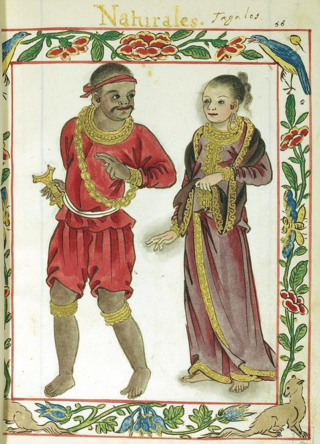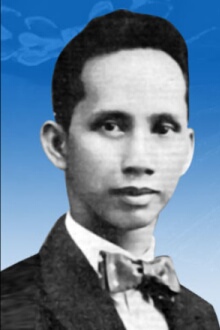Related Research Articles

Melchora Aquino was a Filipino revolutionary. She became known as "Tandang Sora" because of her old age during the Philippine Revolution (1896-1899). She was also known as the "Grand Woman of the Revolution" and the "Mother of Balintawak" for her contributions.

Fermented fish is a traditional preservation of fish. Before refrigeration, canning and other modern preservation techniques became available, fermenting was an important preservation method. Fish rapidly spoils, or goes rotten, unless some method is applied to stop the bacteria that produce the spoilage. Fermentation is a method which attacks the ability of microbials to spoil fish. It does this by making the fish muscle more acidic; bacteria usually cease multiplying when the pH drops below 4.5.

Biag ni Lam-ang is an epic story of the Ilocano people from the Ilocos region of the Philippines. It is notable for being the first Philippine folk epic to be recorded in written form, and was one of only two folk epics documented during the Philippines' Spanish Colonial period, along with the Bicolano epic of Handiong. It is also noted for being a folk epic from a "Christianized" lowland people group, with elements incorporated into the storytelling.
The Philippine Commission was the name of two bodies, both appointed by the president of the United States, to assist with governing the Philippines.

The first Philippine Assembly elections were held across the Philippines on July 30, 1907. The Philippine Organic Act of 1902 established a bicameral Philippine Legislature composed of the appointed Philippine Commission as the upper house and the elected Philippine Assembly as the lower house.
Felipe Landa Jocano was a Filipino anthropologist, educator, and author known for his significant body of work within the field of Philippine Anthropology, and in particular for documenting and translating the Hinilawod, a Western Visayan folk epic. His eminence within the field of Philippine anthropology was widely recognized during his lifetime, with National Artist F. Sionil Jose dubbing him "the country's first and foremost cultural anthropologist"

The recorded history of the Philippines between 900 and 1565 begins with the creation of the Laguna Copperplate Inscription in 900 and ends with the beginning of Spanish colonization in 1565. The inscription records its date of creation in 822 Saka. The discovery of this document marks the end of the prehistory of the Philippines at 900 AD. During this historical time period, the Philippine archipelago was home to numerous kingdoms and sultanates and was a part of the Indosphere and Sinosphere.

Antonio Jesús Naguiat Molina was a Filipino composer, conductor and music administrator. He was named a National Artist of the Philippines for his services to music. He was also known as the "Claude Debussy" of the Philippines due to his use of impressionist themes in music.

The history of the Philippines from 1565 to 1898 is known as the Spanish colonial period, during which the Philippine Islands were ruled as the Captaincy General of the Philippines within the Spanish East Indies, initially under the Viceroyalty of New Spain, based in Mexico City, until the independence of the Mexican Empire from Spain in 1821. This resulted in direct Spanish control during a period of governmental instability there.

Camaron rebosado is a deep-fried battered shrimp dish in Philippine cuisine. It is usually served with a sweet and sour sauce. It is a common dish in Philippine cuisine.

The Philippines–Vietnam relations refers to the bilateral relations of the Republic of the Philippines and the Socialist Republic of Vietnam. Since the end of the Cold War, relations between the two countries have warmed significantly. Vietnam is sometimes referred to as the only communist military ally of the Philippines, especially after Vietnam joined ASEAN in 1995. Both nations have cooperated in the fields of education, tourism, agriculture, aquaculture, trade, and defense. Additionally, both nations have similar positions on the South China Sea issue, with Vietnam backing the Philippine victory in the ICC against China, and the Philippines backing to a certain extent the claim of Vietnam in the Paracels. Both nations have overlapping claims in the Spratlys, but have never made military confrontations as both view each other as diplomatic allies and ASEAN brethren.
1895 in the Philippines details events of note that happened in the Philippines in the year 1895.
The Code of Rajah Kalantiaw was a supposed legal code in the epic history Maragtas of Panay, allegedly written in 1433 by Datu Kalantiaw, a chieftain on the island of Negros in the Philippines. It is now generally accepted by historians that the documents supporting the existence and history of the code, according to some sources, "appear to be deliberate fabrications with no historical validity" written in 1913 by a scholar named Jose Marco as a part of a historical fiction titled Las antiguas leyendas de la Isla de Negros.

The Andrés Bonifacio Monument, commonly known simply as Bonifacio Monument or Monumento, is a memorial monument in Caloocan, Philippines, which was designed by National Artist Guillermo Tolentino to commemorate the Philippine revolutionary Andrés Bonifacio, the founder and Supremo of the Katipunan, who fought for independence from colonial rule by Spain.
Anarchism in the Philippines has its roots in the anti-colonial struggle against the Spanish Empire, becoming influential in the Philippine Revolution and the country's early trade unionist movement. After being supplanted by Marxism-Leninism as the leading revolutionary tendency during the mid-20th century, it experienced a resurgence as part of the punk subculture, following the fragmentation of the Communist Party of the Philippines.

This is a bibliography of works on the Philippines.
Polo y servicio was the forced labor system without compensation imposed upon the local population in the Philippines during the Spanish colonial period. In concept, it was similar to Repartimiento, a forced labor system used in the Spanish America.
References
- ↑ Dominador D. Buhain (1998). A History of Publishing in the Philippines. Quezon City: Rex Bookstore. p. 33. ISBN 971-23-2324-2.
- ↑ Celedonio G. Aguilar (1994). Readings in Philippine Literature. Quezon City: Rex Bookstore. p. 179. ISBN 971-23-1564-9.
- ↑ Michael Barr; Rachel Bean; Mark T. Berger; Chang Chiou Yi; Terence Chong; Christopher Dent; Lawrence Douglas; Michelle Felton; Luisa Igloria; Chris McNab; James Martin; Emmanuel K. Mbobi; Terry E. Miller; Jürgen Neuberg; Ian Proudfoot; Mina Roces; Katen Romano-Young; Henry Russell; Andrew J. Wood (2007). World and Its Peoples: Malaysia, Philippines, Singapore, and Brunei. Tarrytown, New York: Marshall Cavendish. p. 1250. ISBN 0-7614-7642-3.